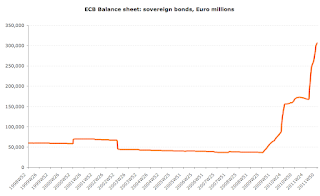Last week's ECB figures show that the Irish banks have managed to rake up €136bn worth of borrowing from Frankfurt as of November 26th. This is an increase of €6bn on end-October figures. Mysteriously little? Not really - Irish banks have also borrowed some €45bn from the Central Bank of Ireland - a rise of €10bn on October.
The reason for such a dramatic increase in borrowing from the CBofI instead of ECB is two-fold:
- ECB is becoming increasingly reluctant to lend to the Irish banks, and
- Irish banks have run out of suitable collateral to pawn at the ECB discount window.
Which, in turn, means 2 things.
Firstly, Irish banks demand for borrowing is not abating despite Nama and other measures undertaken by the Government. Injecting quasi-Governmental paper into banks balancesheets has meant that the banks face immediate loss without any real means for covering it (remember, they can't really count on selling Nama bonds in the market without incurring an extremely steep discount on the value of these notes). Swapping nearly worthless paper for almost totally worthless loans is not doing the job and the entire banking system simply sinks deeper into debt.
Secondly, Irish banks have now uploaded some €45 billion worth of useless paper (that even ECB is unwilling to accept) into the Central Bank of Ireland. How much of this paper is loss-generative and are we, the taxpayers, on the hook for these losses, should the whole pyramid scheme go belly up?
Oh, and in case you wonder - ECB's equity funds are €5.8bn. It's lending side is over €200bn (it was €139bn total - banks lending & sovereign bonds inclusive - as of the end of December 2009), so as a bank, ECB's 2009 leverage was 24 times. Now, it is closer to 35 times. Lehman Bros territory, folks.




